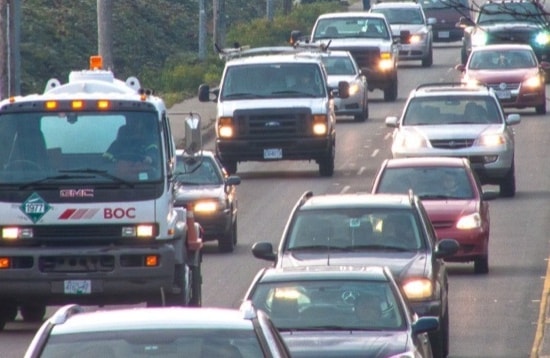An air quality advisory issued Saturday by Metro Vancouver due to high concentrations of ground-level ozone ended Monday morning.
The advisory – the first one of this summer – applied in eastern parts of Metro Vancouver and the Fraser Valley as hot weather broke temperature records in many areas.
B.C.'s Air Quality Health Index continued to forecast a moderate health risk of four (on a scale of 1 to 10) for Monday afternoon and evening in eastern Metro and throughout the Fraser Valley.
During advisory periods, residents are urged to avoid strenuous outdoor activities, especially the elderly, infants and those with respiratory conditions, and seek air-conditioned indoor spaces.
Ground-level ozone is caused when nitrogen oxides and volatile organic compounds react in sunlight on hot days.
VOCs mainly come from vehicle emissions, solvent and fuel evaporation, farming, as well as natural sources such as vegetation.
Emissions from vehicles have steadily declined in recent years due to improving technology, but Metro has projected the recent trend of improving air quality could reverse and worsen from 2020 to 2030, due to growth in Lower Mainland population and traffic.
Both the Metro and Fraser Valley regional districts have lodged concerns with the National Energy Board that the Kinder Morgan pipeline twinning would significantly increase VOC emissions in the region and, as a result, ground-level ozone.
Metro has estimated the increase in VOCs from idling oil tankers and terminal operations would be more than 1,500 tonnes per year, equivalent to adding 13 new oil refineries the size of Chevron's Burnaby refinery.
Residents can help reduce air emissions in the region by minimizing use of vehicles, taking transit or carpooling, minimizing the use of lawn mowers and other gas-powered engines, avoiding idling your vehicle, and avoiding refuelling it at the hottest time of the day.
For air quality health index information see bcairquality.ca, for data on local stations see http://gis.metrovancouver.org/airmap/ and for visual air quality camera views in the Lower Mainland see www.clearairbc.ca/community/Pages/default.aspx.
Smoke from wildfires so far hasn't been a significant problem in the Lower Mainland, except for the Sea-to-Sky corridor around Squamish, where there was significant smoke earlier in the month from the Elaho Valley fire.
But that could change quickly as the wildfire risk is high to extreme in the region.
Previous story:
Residents of the Langleys and the Fraser Valley should avoid strenuous activities during the mid-afternoon, especially the very young, very old and people with lung or heart disease.
Metro Vancouver issued an air quality advisory for eastern parts of the region, saying the heat wave is causing high concentrations of ground-level ozone.
People "experiencing symptoms such as chest discomfort, shortness of breath, or coughing or wheezing" should see a doctor or stay indoors in air-conditioned spaces, the Metro press release states.
Environment Canada describes ground-level ozone as a "colourless and highly irritating gas" that forms just above the earth's surface.
It is called a "secondary" pollutant because it is produced when two primary pollutants react in sunlight and stagnant air, nitrogen oxides (NOx) and volatile organic compounds (VOCs).
About 95 per cent of NOx from human activity come from the burning of coal, gasoline and oil in motor vehicles, homes, industries and power plants.
VOCs from human activity come mainly from gasoline combustion and marketing, upstream oil and gas production, residential wood combustion, and from the evaporation of liquid fuels and solvents.
The Metro Vancouver advisory is expected to continue until there is a change in the current hot and sunny weather.
Residents are being asked to reduce emissions by
· Minimizing the use of vehicles.
· Taking transit or carpooling rather than driving.
· Minimizing the use of other gasoline and diesel engines, such as lawn mowers and trimmers.
· Avoiding refuelling with gasoline during the hottest time of day.
· Avoiding idling vehicle.
